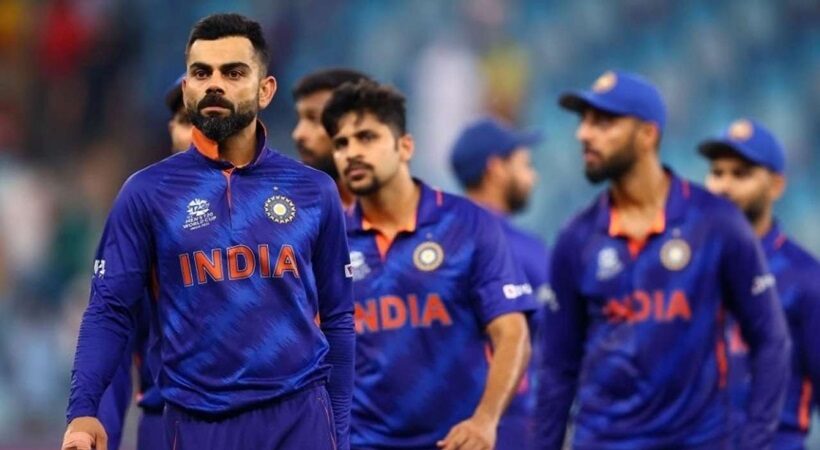“Bad Workers Blame Their Tools” goes a proverb. This adage could not have been more appropriate in the light of India’s early exit from the T-20 carnival unravelling presently in the United Arab Emirates. Everyone from the bowling coach to the players is blaming the dew factor, bio-bubble environment, Toss etc., for Team India’s poor show in the ICC Men’s T-20 World Cup. However, nobody wants to talk about the real factors that ended India’s campaign prematurely. So, it is high time to show the Indian team the mirror, which was one of the few favourites to clinch the title this time, not too long back.
Rohit-Kohli Flop Show
Apart from KL Rahul, none in the top order of the Indian team had a decent outing in the IPL. It is a known fact that Rohit Sharma is as important to India’s scheme of things as the skipper Virat Kohli. However, both had modest outings, by their standards, in the IPL with Rohit scoring 318 from 13 matches and Kohli getting 405 from 15 matches. This was not a good omen for them to enter a marquee event like the world cup, and as a result, they both struggled, especially Rohit, against formidable attacks such as Pakistan and New Zealand. Though Kohli scored a fighting fifty against Pakistan, the knock lacked the desired punch, with India falling short by 30-40 runs in the end. So, the problem for India started at the top with their talismanic players being off-colour in the initial few encounters of the world cup.
Poor Team Selection And The Obsession With Hardik
It remains a mystery why some half-fit players were packed into the side at the expense of some big names and proven performers. Coming to Hardik, it was very apparent that the Baroda all-rounder had not fully recovered coming into the tournament. Then the question arises, why was he picked when India could have either picked a specialist batsman or a bowler. He looked pedestrian, to say the least, with both bat and the ball against Pakistan and New Zealand. There was a question mark over the fitness of Bhuvaneshwar Kumar as well because the Meerut-born pacer looked jaded and uninspiring against Pakistan. Why were these players picked in place of Yuzhvendra Chahal, a genuine wicket-taker in the T-20’s, or Dhawan, a seasoned campaigner who had an excellent IPL with 587 runs from 16 matches? It seems Kohli and Ravi Shastri have a lot to answer when they come back to India before they sign off from their present commitments.
Dhoni’s Role As A Mentor Unclear
Well, it looked like a masterstroke by the Team India management when Mahendra Singh Dhoni was selected to guide the outfit in the coveted event as a mentor. Dhoni has an enviable record as the captain of the CSK in the IPL and possesses an uncanny knack for comprehending a match situation beforehand to take corrective measures. However, as the tournament progressed, his role came under scrutiny as many questioned his basic duties alongside a head coach, bowling coach, fielding coach, captain etc. Did the team management err by having too many talking heads in the decision-making process? For Instance, in the match against New Zealand, why was Rohit’s batting order changed and what was the rationale behind sending a rookie like Ishan Kishen to open the innings along with KL Rahul? Why didn’t they utilise the services of a wrist spinner like Rahul Chahar, considering the dew factor on the UAE pitches? Hence, there were a lot of confused and chaotic calls in the crucial matches that looked like direct consequences of “too many cooks spoiling the broth”.
Lack of Big Match Temper
Since 2013, India has floundered at major hurdles. They lost to Sri Lanka in the final of the 2014 T-20 World Cup, West Indies in the semi-final of the 2016 T-20 World Cup, Australia in the semi-final of the 2015 ODI World Cup, New Zealand in the 2019 ODI World Cup etc., and there are several other misses as well. These slip-ups only prove that India has an issue when it comes to knockout matches. So, the question is, do they lack the big-match temper? Once or twice is natural, but with Team India, it has been a case more often than not. Why does the famed batting lineup come a cropper when it matters the most? Time has come to find answers for all these questions as teams like Pakistan and New Zealand, with scarce resources at their disposal, have produced fabulous results compared to the cash-rich Team India, which has constantly wilted under pressure in critical games. Somebody has to address this issue at the earliest as there is another T-20 World Cup in 2022 and an ODI World Cup in 2023.
Conclusion
There are other factors as well, but these are important aspects that curtailed India’s prospects in the 2020 T-20 World Cup. This is a big jolt for the team and they don’t have enough time to recover as well. So, they need to shrug off the latest disappointment and unleash the brand of cricket they are known for as soon as possible.



















